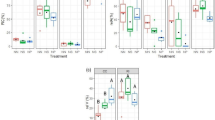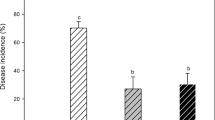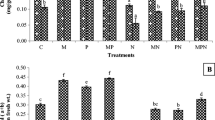Abstract
The plant health promoting rhizobacterium Rhizobium etli G12 known to induce resistance toward root-knot nematodes was shown to increase mycorrhizal establishment when introduced in combination. R. etli promoted the establishment of Glomus intraradices on roots of different tomato cultivars. In vitro studies demonstrated that inoculation with bacteria leads to changes in fungal morphology, including increased hyphal diameter and branching as well as formation of new spores. R. etli seems to be responsible for accelerated arbuscular mycorrhizal (AMF) establishment in tomato roots in concomitant inoculation tests. Therefore R. etli is regarded to be a mycorrhiza helper bacterium. Combined inoculation of R. etli with G. intraradices in biocontrol of Meloidogyne incognita on tomato led to additive effects. Single inoculation of the microorganisms reduced galling by 24 to 39% while dual inoculation resulted in a 60% reduction. The present findings indicate that specific combinations of plant health promoting microorganisms with AMF could lead to improved mycorrhizal colonization and together act as powerful tools in the promotion of both plant growth and health.
Zusammenfassung
Das pflanzenstärkende Rhizosphärebakterium Rhizobium etli G12, welches eine Resistenz gegen Wurzelgallennematoden induzieren kann, hat, bei kombinierter Applizierung mit anderen Mikroorganismen, zu einer Erhöhung der Mykorrhizierung geführt. Entsprechend unterstützte R. etli die Besiedelung der Wurzeln verschiedener Tomatemsorten durch Glomus intraradices. In-vitro-Experimente zeigten, dass eine Inokulation mit dem genannten Bakterium zu einer morphologischen Veränderung des Pilzes geführt hat. So erhöhten sich sowohl der Hyphendurchmesser als auch die Zahl der Verzweigungen, zudem bildeten sich neue Sporen. Der Effekt von R. etli auf die arbuskulären Mykorrhizapilze (AMF) scheint für die beschleunigte Besiedlung von Tomaten mit Mykorrhiza in begleitenden Inokulationsversuchen verantwortlich zu sein, wodurch R. etli als unterstützendes Bakterium für die Mykorrhizierung angesehen werden kann. Eine kombinierte Inokulation von R. etli und G. intraradices hat zu einem additiven Effekt bei der biologischen Bekämpfung des Wurzelgallennematoden Meloidogyne incognita an Tomaten geführt. Einzelinokulation reduzierte die Gallenbildung um 24% bis 39%, wohingegen eine kombinierte Inokulation zu einer Reduktion von 60% geführt hat. Diese neuen Erkenntnisse zeigen, dass pflanzengesundheitsfördernde Mikroorganismen in Kombination mit AMF zu einer erhöhten Mykorrhizierung führen und somit zusammen eine wirkungsvolle Förderung von Pflanzenwachstum und Pflanzengesundheit erreichen können.
Similar content being viewed by others
Literature
Barea, J.M., G. Andrade, V. Bianciotto, D. Dowling, S. Lohrke, P. Bonfante, F. O’Gara, C. Azcón-Aguilar, 1998: Impact on arbuscular mycorrhizal formation of Pseudomonas strains used as inoculants for biocontrol of soilborne fungal plant pathogens. Appl. Environ. Microbiol. 64, 2304–2307.
Barea, J.M., P. Jeffries, 1995: Arbuscular mycorrhizas in sustainable soil-plant systems. In: B. Hock, A. Varma (eds.): Mycorrhiza Structure, Function, Molecular Biology and Biotechnology, pp. 521–559. Springer, Berlin.
Bécard, G., J.A. Fortin, 1988: Early events of vesicular-arbuscular mycorrhiza formation on Ri T-DNA transformed roots. New Phytol. 108, 211–218.
Bianciotto, V., S. Andreotti, R. Balestrini, P. Bonfante, S. Perotto, 2001: Extracellular polysaccharides are involved in the attachment of Azospirillum brasilense and Rhizobium leguminosarum to arbuscular mycorrhizal structures. Eur. J. Histochem. 45, 39–49.
Buchenauer, H., 1998: Biological control of soil-borne diseases by rhizobacteria. Z. Pflanzenk. Pflanzen. 105, 329–348.
Burla, M., M. Goverde, F.J. Schwinn, A. Wiemken, 1996: Influence of biocontrol organisms on root pathogenic fungi and on the plant symbiotic micro-organisms Rhizobium phaseoli and Glomus mosseae. Z. Pflanzenk. Pflanzen. 103, 156–163.
Caron, M., J.A. Fortin, C. Richard, 1985: Influence of substrate on the interaction of Glomus intraradices and Fusarium oxysporum f.sp. radicis-lycopersici on tomatoes. Plant Soil 87, 233–239.
Diedhiou, P.M., J. Hallmann, E.-C. Oerke, H.-W. Dehne, 2003: Effects of arbuscular mycorrhizal fungi and a non-pathogenic Fusarium oxysporum on Meloidogyne incognita infestation of tomato. Mycorrhiza 13, 199–204.
Elsen, A., S. Declerck, D. De Waele, 2001: Effects of Glomus intraradices on the reproduction of the burrowing nematode (Radopholus similis) in dixenic culture. Mycorrhiza 11, 49–51.
Filion, M., M. St-Arnaud, J.A. Fortin, 1999: Direct interaction between the arbuscular mycorrhizal fungus Glomus intrara-dices and different rhizosphere micro-organisms. New Phytol. 141, 525–533.
Garbaye, J., 1994: Helper bacteria: a new dimension to the mycorrhizal symbiosis. New Phytol. 128, 197–210.
Grandison, G.S., K.M. Cooper, 1986: Interactions of vesicular-arbuscular mycorrhizae and cultivars of alfalfa susceptible and resistant to Meloidogyne hapla. J. Nematol. 18, 141–149.
Hallmann, J., A. Quadt-Hallmann, W.G. Miller, R.A. Sikora, S.E. Lindow, 2001: Endophytic colonization of plants by the biocontrol agent Rhizobium etli G12 in relation to Meloid-ogyne incognita infection. Biol. Control 91, 415–422.
Hasky-Günther, K., S. Hoffmann-Hergarten, R.A. Sikora, 1998: Resistance against the potato cyst nematode Globodera pallida systemically induced by the rhizobacteria Agrobacterium radiobacter (G12) and Bacillus sphaericus (B43). Fundam. Appl. Nematol. 21, 511–517.
Hildebrandt, U., K. Janetta, H. Bothe, 2002: Towards growth of arbuscular mycorrhizal fungi independent of a plant host. Appl. Environ. Microbiol. 68, 1919–1924.
Hussey, R.A., K.P. Barker, 1973: A comparison of methods for collecting inocula for Meloidogyne sp., including a new technique. Plant Dis. Report. 57, 1025–1028.
Jones, J.P., R.E. Stall, T.A. Zitter, 1991: Compendium of Tomato Diseases. Aps Press.
King, E.O., M. Warth, E.D. Raney, 1954: Two simple media for the demonstration of procyanin and fluorescein J. Lab. Clin. Med. 44, 301–307.
Linderman, R.G., 1988: Mycorrhizal interactions with the rhizosphere microflora: The mycorrhizosphere effect. Phytopathology 78, 366–371.
Linderman, R.G., 1994: Role of VAM fungi in biocontrol. In: F.L. Pfleger, R.G. Linderman (eds.): Mycorrhizae and Plant Health, pp. 1–25. APS Press, St. Paul, MN.
Mosse, B., 1962: The establishment of vesicular-arbuscular mycorrhiza under aseptic conditions. J. Gen. Microbiol. 27, 509–520.
Paulitz, T.C., R.G. Linderman, 1989: Interactions between fluorescent pseudomonads and VA mycorrhizal fungi. New Phytol. 113, 37–45.
Powell, C.L.L., 1976: Development of mycorrhizal infections from Endogone spores and infected root segments. T. Brit. Mycol. Soc. 66, 439–445.
Racke, J., R.A. Sikora, 1992: Isolation, formulation and antagonistic activity of rhizobacteria toward the potato cyst nematode Globodera pallida. Soil Biol. Biochem. 24, 521–526.
Raupach, G.S., J.W. Kloepper, 1998: Mixtures of plant growth-promoting rhizobacteria enhance biological control of multiple cucumber pathogens. Phytopathology 88, 1158–1164.
Reimann, S., R.A. Sikora, 2003: Managing the mycorrhizosphere — an approach to sustainable agriculture after the phaseout of methyl bromide. Comm. Agric. Appl. Biol. Sci. 68, 129–134.
Reitz, M., S. Hoffmann-Hergarten, J. Hallmann, R.A. Sikora, 2001: Induction of systemic resistance in potato by rhizobacterium Rhizobium etli strain G12 is not associated with accumulation of pathogenesis-related proteins and enhanced lignin biosynthesis. J. Plant Dis. Protect. — Z. Pflanzenk. Pflanzen. 108, 11–20.
Reitz, M., K. Rudolph, I. Schröder, S. Hoffmann-Hergarten, J. Hallmann, R.A. Sikora, 2000: Lipopolysaccharides of Rhizobium etli strain G12 act in potato roots as an inducing agent of systemic resistance to infection by the cyst nematode Globodera pallida. Appl. Environ. Microbiol. 66, 3515–3518.
Saleh, H.M., R.A. Sikora, 1984: Relationship between Glomus fasciculatum root colonisation of cotton and its effect on Meloidogyne incognita. Nematologica 30, 230–237.
Sikora, R.A., 1995: Vesicular-arbuscular mycorrhizae: their significance for biological control of plant parasitic nematodes. Biocontrol 1, 29–33.
Sikora, R.A., E. Fernández, 2005: Nematode parasites of vegetables. In: M. Luc, R.A. Sikora, J. Bridge (eds.): Plant Parasitic Nematodes in Subtropical and Tropical Agriculture. Cab International, Wallingford.
Sikora, R.A., S. Hoffmann-Hergarten, 1993: Biological control of plant parasitic nematodes with plant-health-promoting rhizobacteria. In: R.D. Lumsden, J.L. Vaughn (eds.): Pest Management: Biologically Based Technologies. Proceedings of Beltsville Symposium XVIII. American Chemical Society, Washington, DC.
Sikora, R.A., S. Reimann, 2004: Suppressive soils, the edge of chaos and multitrophic strategies for biocontrol of pests and diseases in soil ecosystems. IOBC WPRS Bull. 27, 251–258.
Sikora, R.A., R.-P. Schuster, 2000: Handbuch der Phytonematologie. Shaker Verlag, Aachen.
Smith, G.S., 1988: The Role of phosphorus nutrition in interactions of vesicular-arbuscular mycorrhizal fungi with soil-borne nematodes and fungi. Phytopathology 78, 371–374.
Smith, G.S., R.S. Hussey, R.W. Roncadori, 1986: Penetration and postinfection development of Meloidogyne incognita on cotton as affected by Glomus intraradices and phosphorus. J. Nematol. 18, 429–435.
Smith, S.E., F.A. Smith, I. Jakobsen, 2003: Mycorrhizal fungi can dominate phosphate supply to plants irrespective of growth responses. Plant Physiol. 133, 16–20.
Trouvelot, A., J.L. Kough, V. Gianinazzi-Pearson, 1986: Mesure du taux de mycorhization VA d’un système radiculaire. Recherche de méthodes d’estimation ayant une signification fonctionnelle. In: V. Gianinazzi-Pearson, S. Gianinazzi (eds.): Physiological and Genetical Aspects of Mycorrhizae, pp. 217–221. Inra Press, Paris.
Vierheilig, H., A.P. Coughlan, U. Wyss, Y. Piché, 1998: Ink and vinegar, a simple staining technique for arbuscular-mycorrhizal fungi. Appl. Environ. Microbiol. 64, 5004–5007.
Weller, D.M., 1988: Biological control of soilborne plant pathogens in the rhizosphere with bacteria. Annu. Rev. Phytopathol. 26, 379–407.
Whipps, J.M., 1997: Developments in the biological control of soilborne pathogens. Adv. Bot. Res. 26, 1–133.
Whipps, J.M., 2001: Microbial interactions and biocontrol in the rhizosphere. J. Exp. Bot. 52, 487–511.
Wyss, P., T.H. Boller, A. Wiemken, 1992: Testing the effect of biological control agents on the formation of vesicular arbuscular mycorrhiza. Plant Soil 147, 159–162.
Author information
Authors and Affiliations
Corresponding author
Rights and permissions
About this article
Cite this article
Reimann, S., Hauschild, R., Hildebrandt, U. et al. Interrelationships between Rhizobium etli G12 and Glomus intraradices and multitrophic effects in the biological control of the root-knot nematode Meloidogyne incognita on tomato. J Plant Dis Prot 115, 108–113 (2008). https://doi.org/10.1007/BF03356249
Received:
Accepted:
Published:
Issue Date:
DOI: https://doi.org/10.1007/BF03356249




